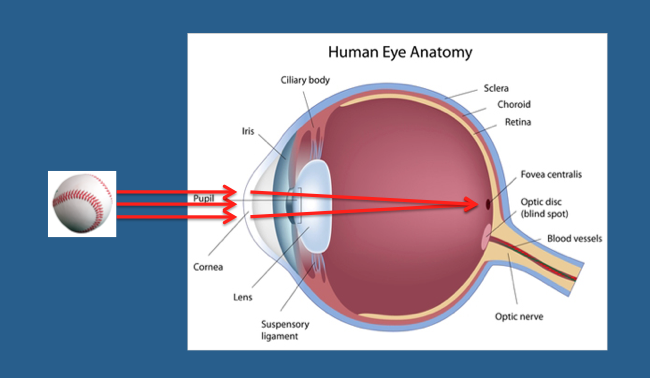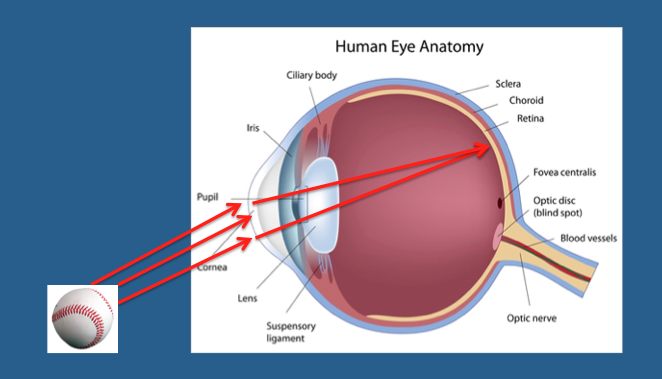The science of “looking” at the ball
October 27, 2014 by Coach McCreary
Filed under Coaching, Hitting
When I work with younger kids I often say “there is a big difference between ‘seeing’ the ball and ‘looking’ at the ball when hitting.”
You can “see” the ball out of the corner of your eye but “looking” at the ball means turning your head until your whole face is directed at the ball. Having your whole face directed at the ball will give you a much better look at the ball.
And science proves it.
Here is a diagram of the human eye “looking” at a baseball …
When an object is in front of you (looking at it), the eye takes in the image (light waves) and focusses it onto the sweet spot (the fovea) of the retina which is the back of the eye ball. The retina is made up of rods and cones (photoreceptors) that turn the light energy into something the brain can understand (neural impulses). Cones, which handle colors and detail of the image, are abundant in the fovea. That’s why when you turn and look at something the detail and color of it get sharper.
Now look what happens when you see the ball in your peripheral vision …
The image is projected onto a different part of the retina. That part of the retina is mostly made up of rods which detect movement and work well in low light conditions but don’t handle color or detail. That’s why things seen at night have no color and not much detail. The rods have taken over.
Try this and you’ll see what I mean. Take a baseball and put it in either hand. Focus your eyes on something straight ahead and extend the ball straight out to the side so you cannot see it. Keep looking forward and slowly move the ball forward until you can see it in your peripheral vision. You will not be able to see the color of the laces or much detail until the ball comes farther out in front of your face. The rods of your eye are working when the ball is to the side and the cones kick in the more the ball moves in front of your face.
We have all taught kids to “watch the ball hit your bat.” Now you know the science behind it. Just make sure they are looking at the ball to contact and not just seeing it out of the corners of their eyes.
Tomorrow’s post: Great from pitch #1







Great post Coach,
This past year I changed my phrase from eye on the ball to nose on the ball, with the nose on the ball you have to see it, not only for hitting feilding as well. I think that texting and and useing computers etc trains use to use our peripheral vision and we have to work harder to train our players to actully look at the ball.
Just my opinion but I have had better results teaching them to put their nose on the ball for ever part of the game.
Thanks,
CC